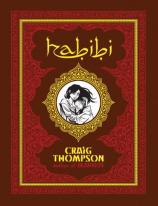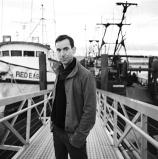Epic Journey: Craig Thompson Talks Habibi
With Habibi, Craig Thompson elevates the graphic novel form to even higher levels. Here, he discusses the work that went into creating this masterpiece and the implications its winding, twisted, religiously and socially inspired tales create. Also, Craig shares some of the work-in-progress artwork that went into creating Habibi.
Was Habibi fun for you to write and work on? Was it a labor of love? Or, given how huge an undertaking this must have been, was it often a burden you were carrying?
Perhaps ironically, cartooning isn't generally fun. The daydreaming it up portion is playful and then the rest is simply hard work, hammering away at the forge. AndHabibi specifically was a project that invited challenges. It was a dive into darkness for both the characters Dodola and Zam, and their creator. And it explored themes of drought—of course, environmental drought and water crisis. But also emotional drought, sexual drought, spiritual drought—and for me, bouts of creative drought. That theme of rivers being blockaded by dams cast its own spell—I encountered my own walls and had to break on through to the other side. All that said, it's fair to label it a labor of love.
This isn’t the story most would expect from you after Blankets. What inspired this kind of epic from you?
After Blankets, I was sick of drawing myself. Sick of drawing these mundane Midwestern landscapes. I wanted to draw something outside of myself, something bigger. And I considered two directions: 1) a fantasy epic, like Lord of the Rings (!) or 2) a nonfiction piece of social/political relevance, a la the comics journalism of Joe Sacco. Habibi ended up meeting in the middle. It’s a fairytale borrowing from the Orientalist conventions of the One Thousand and One Nights, but also drawing from contemporary topics of sex, religion, and water crisis.
The length, in my opinion, is a byproduct of the comics form. It takes pages of comics to convey the same information captured in a paragraph of prose. So a comic book with novelistic intentions inevitably ends up mammoth. My style tends to be manga-esque: fast-paced and breathable, so that also requires a longer page count. Pages can be like water level—you need enough depth for the reader to be fully immersed—to drown in even!
Similarly, this applies to the detailed drawing style in Habibi. Layers and layers of ornament are heaped on the comics page—this is an homage to the tradition of engraved book illustrations and to Symbolism and most of all to the Arabic and Islamic artistic traditions of calligraphy, pattern, and geometric design.
An obvious question is that this is being released around the tenth anniversary of the 9/11 attacks. Was that in your mind at all as you worked on the book and planned the release? Were the events of that day and the ensuing tensions regarding Islamism (and often mistaken views regarding its followers) a factor in what made you want to do this book?
Yes, there was a “post 9/11” energy that informed Habibi. Islam was being vilified by the media, and I sought to humanize Islam, to both focus on its beauties and to understand it. As I met and conversed with more Muslims, it was obvious that they were no different from the devout Christian communities I grew up in. They shared the same values and lifestyles and the same stories. In both faiths, there’s casual/”default” believers and fundamentalist extremists, and most fall in the soft middle. If anything, the anti-Islamic sentiment that arose in the States felt like self-loathing, against our own brand of religious fundamentalism. Perhaps more important, my research opened me to the inspiration of Arabic calligraphy and geometric design and ornamentation and architecture—all these artistic directions that evolved so incredibly because of the supposed prohibition of representational arts.
Given that this was such a massive undertaking, how long did you spend working on Habibi?
Six years.
Have you studied the Quran extensively? How much or how little were you familiar with it when you decided to embark on this book?
Writing Habibi inspired me to pick up and read the Quran for the first time. But reading it in English is not the ideal way to experience it—it’s classically in Arabic, which I can’t comprehend. And it’s meant to be recited and heard—to be encompassed in the sound of its beauty. That said, even the English textual version of the Quran is beautiful to me. It’s poetic like my favorite books of the Bible—Psalms, Ecclesiastes, Song of Songs—and because it’s less linear and in some ways more abstract than the Bible, it works in tandem with an understanding of classic Bible stories.
The Quranic accounts are rarely different from the Biblical versions, and I thought this would be surprising to most Christians. I sought the commonalities in the stories. But it was also fun to follow the details where they diverged. I don’t see Biblical stories as historical accounts, but potent myths that shape our worldviews.
How will you follow up Habibi? Have you already started on your next project, and if so, is there anything you can tell us about it?
I’m definitely planning shorter projects. French cartoonist David B. advised me that he always juggles at least two projects simultaneously so that no one project becomes too oppressive or laborious. The filmmakers the Cohen Brothers claim the same—creative block lessens when you can shift your attentions between multiple projects. So I’ve got three disparate books I’ve started brainstorming on. But with months and months of Habibi promotion and touring ahead of me, I’ll be kept apart from the drawing board and the new dreams I’d like to get on paper.




